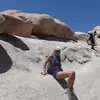Chilling winds, freezing temperatures and substantial snowfall: this is what you might get on a winter camping trip, and you need a tent that can handle it all. "It should keep out the cold, stand up to strong winds, brush off heavy snow, and generally repel all forms of precipitation. It also should ventilate well," says Michael Lanza, a travel expert for GORP.com.
Here's a breakdown of what your winter tent needs for a successful camping trip in the offseason.
More: 5 Convincing Reasons to Camp in the Winter
Space
You'll spend a lot of time in your tent, where it's warm, and safe from the winter elements. When you purchase the tent, be sure to test the inside space; can you sit up, breathe easily, and move around? You should be comfortable both sleeping and relaxing inside.
What's just as important as sleeping space is having a place to protect your gear from the weather. The best winter tents have a vestibule, preferably attached to the tent itself, as opposed to an accessory you purchase afterwards. This not only helps you keep snow from getting inside the tent, but it's a place that your gear can sit when not in use.
More: How to Stay Organized While Camping
Weight
Most winter campgrounds are walk- or hike-in only, so your tent has to be light enough to carry in a backpack along with all your other gear. Purchase a 2-person tent that weighs 2 to 3 pounds, if not less. The inside of a tent like this will be small, but provide enough space to sleep comfortably.
Protection From the Elements
Your winter tent needs to be rugged and strong despite being light and easy to carry. There are a few important features that can help make this happen.
Multiple poles: "As a general rule, stability increases as the number of pole intersections goes up," says Matt Heid of the Appalachian Mountain Club. However, more pole intersections often means there are more poles to put up and not every winter camping trip requires the extra poles. Consider where you camp and the anticipated weather to determine if this feature is necessary.
Fly: The fly for summer tents usually reaches only halfway down the sides, whereas a winter tent fly should go all the way to the ground. This helps to keep snow off your tent walls and from sneaking inside, as well.



